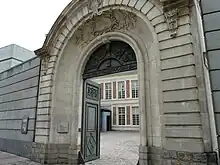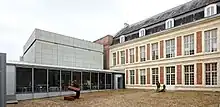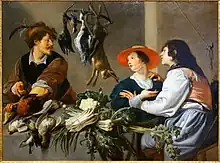Musée des Beaux-Arts de Cambrai
The Musée des Beaux-Arts de Cambrai (English: Cambrai Museum of Fine Arts), also known as the Musée de Cambrai, is the main museum in the northern French city of Cambrai. It holds collections of archaeology, visual arts and local heritage. Of particular note among the holdings are works by Flemish and Dutch painters of the 17th century and French artists of the 19th and 20th centuries; a collection of osteoarchaeology which is unique in France; and a copy of a plan-relief of the city as it appeared in the reign of Louis XIV.[2]
 | |
| Established | 2 May 1847 |
|---|---|
| Location | Cambrai, Hauts-de-France, France |
| Coordinates | 50°10′23″N 3°13′47″E |
| Visitors | 30,000[1] (2003) |
History

The museum was created in 1847 to present to the public the remnants of the revolutionary seizures made in the old episcopal city of Cambrai.[3] The museum was originally housed in the former offices of the National Guard located in the town hall. It was enriched in the following years by purchases, donations and deposits from the State. Among other items, the Musée de Cambrai received in 1863 forty-three pieces of Greek and Etruscan ceramics from the collection of the disgraced Italian art collector Giampietro Campana.[4]
Between 1860 and 1870, the museum opened up to regional history (archaeology and lapidary). In 1865 the collections were transferred to the nuns' chapel and refectory of the former Saint-Julien hospital. The fine arts collections were enriched, and contemporary art was given a prominent place.
The substantial growth of the collections led to their transfer in 1893 to the Hôtel de Francqueville, one of the most beautiful mansions built in the 18th century in Cambrai.[Note 1] The wealthy industrialist Auguste Legrand had just bequeathed the building to the city to present the collections of the municipal museum, and the living rooms were appropriate for this function. The new museum, designed by the architect Veret, was inaugurated in the spring of 1893. The transfer of the museum to the Hôtel de Francqueville[2] led to new acquisitions from the State and a series of donations. The most important was that of Ernest Delloye who donated the former collection of Mgr Belmas which had been entrusted to him (about two hundred objects: bronzes, art objects, porcelain, jewellery, paintings, etc.) and his own collection of a considerable number of documents and objects relating to the history of Cambrai.
During the First World War, the building was partially damaged and the museum lost much of its collections: in March 1918, a bomb had ripped open the roof and floors of the first floor and cracked the walls. One hundred and seventy-three paintings, eight sculptures and almost the entire Belmas collection were destroyed. In 1924 part of the museum was reopened, with an acquisition policy favouring artists from northern France who had won prizes at the Salon des artistes français before the war. The entire museum was reopened on 14 May 1933.[3]
The contents of the museum were completely evacuated for safeguarding following the declaration of the Second World War. The museum was subsequently reopened in two stages: the first in August 1946, the second a year later.
Renovated and enlarged between 1989 and 1994 by the architects Jean-François Bodin and Thierry Germe,[5] the Cambrai museum now integrates contemporary architectural design.[6] The museum was redesigned and renovated again in 2018, and the collection was rehung.[7][8]
The collections are spread over four levels in a chronological route from prehistory to 20th century art.[9]
Curators
| Start date | End date | Curator |
|---|---|---|
| 1884 | 1892 | Achille Durieux |
| 1892 | 1898 | Édouard Gautier |
| 1898 | 1917 | Émile Mussault |
| 1919 | 1921 | Jules Renaut |
| 1921 | 1928 | Georges Leboyer |
| 1927 | 1933 | Georges Maroniez |
| 1934 | 1952 | Ernest Gaillard |
| 1952 | 1962 | Gérard Bayle |
| 1964 | 1987 | Michel Bouvy |
| 1987 | 2001 | Françoise Magny |
| 2001 | 2010 | Véronique Burnod |
| 2011 | 2014 | Maël Bellec |
| 2014 | 2022 | Alice Cornier |
| 2023 | Florence Albaret (interim)[10] |
Collections


The museum has three departments, displayed over four floors:[3][11]
- Archaeology, including prehistory, classical archaeology (Etruria, Greece) and that of the Gallo-Roman period in the North of France, with particular sections devoted to the Merovingian period, and an osteoarchaeology section which is unique in France.
- Visual arts: Flemish and Dutch painters of the 17th century including David Teniers the Younger, Theodoor Rombouts, Joos de Momper, Frans Francken the Younger, Bartholomeus van der Helst, Adam Frans van der Meulen;[12] and artists of the 19th[13] and 20th centuries, including Jean-Auguste-Dominique Ingres, Théodore Chassériau, Eugène Boudin, Camille Claudel, Auguste Rodin, Antoine Bourdelle, François Pompon, Auguste Herbin, Maurice Utrillo, Kees van Dongen, Sonia Delaunay, Suzanne Valadon, Victor Vasarely, Henri Le Sidaner, Geneviève Claisse, Jean Signovert, Guy de Lussigny, and others.
- Heritage of Cambrai, including a plan-relief of the city as it appeared in 1711, a faithful reconstruction of the original plan which disappeared in Berlin in 1945, supported by an animation which retraces the history of the city.
Works
Painting
- Workshop of Hyacinthe Rigaud, Portrait of Louis XIV, 17th century, oil on canvas.
- Jan Miel, Aeneas and Dido Hunting, 17th century, oil on canvas.
- Jean-Auguste-Dominique Ingres, Head of Large Reclining Odalisque, 19th century, oil on canvas.
- Carolus-Duran, Full-length Portrait of the Marquise d'Anforti, 1873, oil on canvas.
- Louis Marie De Schryver, The Merchant of Four Seasons.
- Suzanne Valadon, Madame Lévy, 1922, oil on canvas.
- Kees van Dongen, Madame Jeanne Mathis, 1968, oil on canvas.
- Henri Malvaux, Landscape, 20th century, oil on canvas.
- Clémentine Hélène Dufau, Portrait of Countess Anna de Noailles, 1914, oil on canvas.
- Henri Le Sidaner, The Closed Shutters, Gerberoy, 1935, oil on wood.
Sculpture
- Théophile Bra, Pierre de Francqueville, Sculptor of Henri IV, 1825, white marble bust.
- Jean-Baptiste Carpeaux, Young Girl with a Shell, 1864, bronze statue.
- Auguste Rodin, Saint John the Baptist Preaching, or the Man of the Desert, 1879, plaster statue.
- Auguste Rodin, Victor Hugo, 1883, plaster bust.
- Antoine Bourdelle, Bust of Anatole France, early 20th century.
Plan-relief model
The Cambrai Museum displays a copy of the plan-relief of the city, produced in 1994 during the restoration of the museum.
The first plan-relief of the city of Cambrai was produced around 1695 under the direction of the Marquis de Louvois at the request of the Marquis de Vauban, and exhibited at the Louvre and then at Les Invalides thereafter. During the Hundred Days in 1815, it was taken by the Prussians and exhibited in the Arsenal Museum in Berlin as a war trophy. Still present in the Arsenal before the First World War, it may have disappeared before the Second World War during a restructuring of the collections. In any case, the Allied bombings of Berlin in 1945 led to the burning of the Arsenal. In 1948, the model's base was found, damaged by debris. Photographs taken before the destruction and old plans made it possible to restore the plan-relief in the form of a scale copy, animated by sound and light.[2]
Notes
- Between April 1719 and December 1720 Jean-Baptiste de Francqueville, seigneur of Bourlon, had built the Hôtel de Francqueville, a Parisian-style hôtel particulier entre cour et jardin, appropriate for his position as adviser-secretary to King Louis XIV in the newly conquered territory of Cambrai.
References
- "Rapport de présentation" (PDF). Schéma de cohérence Territoriale du Cambrésis (in French). Pays du Cambrésis. 20 October 2011.
- Magny, Françoise (30 June 1997). Le Musée de Cambrai (in French). Paris: Réunion des Musées Nationaux. ISBN 978-2711835850.
- "Musée de Cambrai". POP: the open heritage platform (in French). Ministère de la Culture (Ministry of Culture (France)). 21 January 2019. Retrieved 25 April 2023.
- "Musée de Cambrai, la collection Campana" (PDF). Tourisme Cambrésis (in French). Association Office de Tourisme du Cambrésis. 1 August 2012. Retrieved 28 April 2023.
- "Musée des Beaux-Arts de Cambrai". Musenor (in French). L'Association des conservateurs des musées des Hauts-de-France. Retrieved 25 April 2023.
- Bodin, J-F; Germe, T (1995). "Renovation Du Musee De Cambrai". Architecture intérieure-Créé (in French). Archicree, S.E.P. (264): 46.
- "Le musée des Beaux-Arts de Cambrai rouvre ses portes (The musée des Beaux-Arts de Cambrai reopens its doors)". Ministère de la Culture (in French). Ministère de la Culture - DRAC Hauts-de-France. 17 October 2018. Retrieved 26 April 2023.
- Bacino, Lorenza (2018). "Musée des Beaux-Arts de Cambrai: A grand re-opening with many previously unseen works". Discover Benelux. Scan Client Publishing. Retrieved 28 April 2023.
- Couturier, Emmanuelle (1 May 2009). Musées de France en Nord et Pas-de-Calais: Terre d'arts et de cultures (in French). La Voix du Nord. ISBN 978-2843931321.
- "Et en 2023… C'est Florence Albaret, directrice du pôle des affaires culturelles, qui va assurer l'intérim à la tête du musée de Cambrai, à compter de ce début janvier. (And in 2023… Florence Albaret, director of the cultural affairs department, who will take over as interim head of the Cambrai museum, from the beginning of January.)" (in French). La Voix du Nord. 30 December 2022. Retrieved 26 April 2023.
- "Dossier pédagogique (Education file: Museum Overview)". Musenor (in French). L'Association des conservateurs des musées des Hauts-de-France. Retrieved 25 April 2023.
- Burnod, Véronique; Hebert, Tiphaine; Rollandi, Marieke; Carpentier, Anne; Matton, Marie-Claire. "Dossier pédagogique: L'émergence de la bourgeoisie aux XVIIe et XVIIIe siècles France et Provinces Unies (Education file: The rise of the bourgeoisie in the 17th and 18th centuries in France and United Provinces)". Musenor (in French). L'Association des conservateurs des musées des Hauts-de-France. Retrieved 25 April 2023.
- Burnod, Véronique; Hebert, Tiphaine; Rollandi, Marieke; Matton, Marie-Claire. "Dossier pédagogique: Quel regard l'artiste du XIXe siècle pose-t-il sur le monde rural? (Education file: How did the 19th century artist see the rural world?". Musenor (in French). L'Association des conservateurs des musées des Hauts-de-France. Retrieved 25 April 2023.
Bibliography
- Couturier, Emmanuelle (1 May 2009). Musées de France en Nord et Pas-de-Calais: Terre d'arts et de cultures (in French). La Voix du Nord. ISBN 978-2843931321.
- Magny, Françoise (30 June 1997). Le Musée de Cambrai (in French). Paris: Réunion des Musées Nationaux. ISBN 978-2711835850.
- Wiard, Laurent; Deschamps, Stéphanie; Deloffre, Véronique; Hanotte, Alice (15 May 2007). Nord, Terre de création : Chefs-d'oeuvre des musées du Nord - Pas-de-Calais (in French). Illustria Librairie des musées. ISBN 978-2912241115.